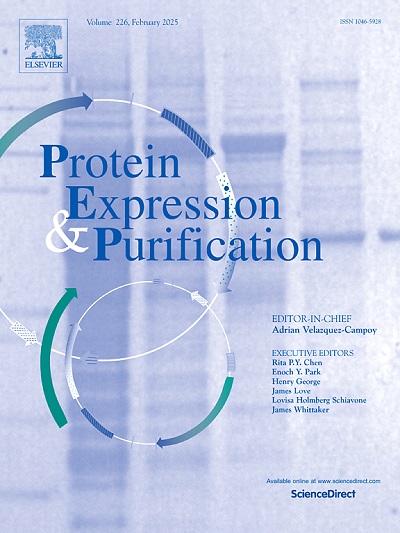Functional expression of five refolded recombinant variants of RBD from SARS-CoV-2 in Escherichia coli
IF 1.2
4区 生物学
Q4 BIOCHEMICAL RESEARCH METHODS
引用次数: 0
Abstract
Production of the receptor binding domain, RBD, variants of SARS-CoV-2, has been necessary to understand their interaction with the human receptor ACE2 and to develop alternative strategies against COVID-19. Affordable bacterial production can aid in these efforts and offer alternatives to address the ongoing emergence of new variants. Expressing recombinant RBD in E. coli could provide a valuable alternative if the challenges related to disulfide bond formation, low solubility, and the absence of glycosylation capabilities are addressed in this heterologous expression system. In this study, five representative RBD variants were expressed in E. coli BL21 (two versions of the RBD Wuhan sequence (Wt), Delta, Omicron BA.2, and Omicron JN.1). The resulting inclusion bodies were solubilized using guanidine chloride and refolded in the presence of a buffer containing the redox couple GSH-GSSG and L-arginine monohydrochloride. Purification was achieved through size-exclusion chromatography. These purified RBD variants were analyzed and compared to the RBD with the Wuhan sequence and the Omicron BA.5 variant, both produced in Chinese Hamster Ovary cells, regarding their ability to bind to ACE2 and using surface plasmon resonance, SPR, studies. The strategy outlined in this work did not include expression studies or a complete comparison of the expression yields obtained in relation to other expression systems. However, it clearly demonstrates the feasibility of obtaining various RBD variants, capable of binding to ACE2, starting from inclusion bodies, and exhibiting comparable affinities to those RBD variants produced in eukaryotic cells. This approach provides an additional option to enhance the existing tools available for research laboratories studying interactions between biologically active RBD variants and ACE2.

五种重组SARS-CoV-2 RBD变体在大肠杆菌中的功能表达
为了了解SARS-CoV-2的受体结合域RBD变体与人类受体ACE2的相互作用,并制定针对COVID-19的替代策略,有必要生产RBD。负担得起的细菌生产可以帮助这些努力,并为解决不断出现的新变种提供替代方案。如果在大肠杆菌中表达重组RBD可以解决与二硫键形成、低溶解度和缺乏糖基化能力相关的挑战,那么在大肠杆菌中表达重组RBD可以提供一个有价值的替代方案。在本研究中,在大肠杆菌BL21中表达了5种具有代表性的RBD变体(RBD武汉序列的两个版本(Wt), Delta, Omicron BA.2和Omicron JN.1)。所得到的包涵体用胍氯溶解,并在含有氧化还原偶对GSH-GSSG和l -精氨酸单盐酸的缓冲液存在下重新折叠。通过排色层析进行纯化。对这些纯化的RBD变体进行了分析,并与武汉序列的RBD和Omicron BA.5变体(均在中国仓鼠卵巢细胞中产生)进行了比较,分析了它们与ACE2结合的能力,并利用表面等离子体共振(SPR)进行了研究。这项工作中概述的策略不包括表达研究或与其他表达系统获得的表达量的完整比较。然而,它清楚地证明了从包涵体开始获得各种能够与ACE2结合的RBD变体的可行性,并且与真核细胞中产生的RBD变体具有相当的亲和力。这种方法为研究实验室研究生物活性RBD变体与ACE2之间相互作用的现有工具提供了一个额外的选择。
本文章由计算机程序翻译,如有差异,请以英文原文为准。
求助全文
约1分钟内获得全文
求助全文
来源期刊

Protein expression and purification
生物-生化研究方法
CiteScore
3.70
自引率
6.20%
发文量
120
审稿时长
32 days
期刊介绍:
Protein Expression and Purification is an international journal providing a forum for the dissemination of new information on protein expression, extraction, purification, characterization, and/or applications using conventional biochemical and/or modern molecular biological approaches and methods, which are of broad interest to the field. The journal does not typically publish repetitive examples of protein expression and purification involving standard, well-established, methods. However, exceptions might include studies on important and/or difficult to express and/or purify proteins and/or studies that include extensive protein characterization, which provide new, previously unpublished information.
 求助内容:
求助内容: 应助结果提醒方式:
应助结果提醒方式:


